(or Triads, Trimurties, Triple Deity, Triunities, Trebles, Triangles, Triskelions, etc...?)
Correlations, Coincidences, or Compatible connections of a comparative cognition?
| 1st of 1st | 2nd of 1st | 3rd of 1st |
| 2 | 3 | 4 |
| 5 | ||
~ The Study of Threes ~
http://threesology.org
Visitors as of September 13th, 2024
One of the problems people have in accepting that the Sun has had such an influential role in biology and psychology is that not everything exhibits a stright-forward "three" or "three-to-one" pattern when subjected to the imagination of humanity, even when humanity is striving to unravel basic structures, processes, and representations thereof. If the Sun does have such an impact, then some believe this influence should be universal and not piecemeal as it appears when examining different examples of threes. In attempting to answer why everything does not exhibit the three-to-one (trinity) pattern, we must recognize that there exist examples of biological behavior which respond to specific solar effects such as when plants respond to the Sun during certain time and at other times appear to be unresponsive... or at least that is how we describe it.
For example, using the terms photo-periodism and photo-tropism to describe biological behavior in rhythm to the Sun at particular times, we encounter life forms which do not appear to reflect having developed a "three" behavior, perhaps because we haven't had reason to look for that which may occur subtly or on a more basic level such as the three-chromosome recurrence amongst food crops. Then again, if one resorts to the suffix "Tropism" as a singular entity, we find that it can be linked to other forms of influence that may distract us from looking too closely at any numerically-referenced pattern if the pattern involves the usage of examples that are aligned or linked with articles associated with interpretations that may be entertaining or interesting, but are otherwise interpreted as that which one can not takk too seriously unless one possesses an advocacy viewed with suspicion such as superstition, religion, extra-terrestrial definitions, conspiracy theory, etc., even though such subjects provide information that can be enumerated and thus provide examples of human mental activity... over-time, even if the material under examination is a product of human imagination.
In other words, the idea that the Sun is able to influence a specific pattern such as a three-to-one ratio is not a topic you will find in conventional biology courses, nor for that matter as a discussion amongst students of philosophy or theology, not to mention psychology. While psychology students and the general public may peruse the idea of the full Moon affecting behavior, or eclipses, sunspots, and other such overt generalities thought to be specificities; the idea of identifying a numerical reference in belief and behavior is not a customary consideration. Like plants, different life forms may be "tuned-in" to a very narrow range of the Sun's influence, thus suggesting a type of spectrum indicated by different ideological parameters. For example, while some ideas exhibit a three-patterned structure and others a 3 to 1 pattern, others exhibit a one or two-pattern. Multiplicity or plurality could well be an expression of the "Many, Much, Several" mental application found in early number systems used by those whose sophistication of numerousity was at a very primitive level, just as is the human body... unless someone wants to suggest our bodies have evolved to the point of having an individual consciousness.
Another problem is that people do not think about the Sun as an environmental influence which exhibits patterns that can be enumerated.
A third problem is that the Sun is not being viewed as an event which is undergoing an incremental deterioration (it is burning out), along with a deterioration in the rotation of the Earth and the Moon is receding. All three are altering behavior and these alterations will affect our society, our psychology and our physiology... to name but three of many human circumstances.
However, as will be described in the present page involving the "Trinity" concept, I explain that the word is not owned by Religion, but neither are morality and God. Whereas I had first started out with an intent to provide a few examples of three-patterned and three-to-one patterned references from a variety of subjects and interests, the more I worked at the idea, the clearer it became that there was a great need for an expansive review. Though I initially thought to place the list of examples first because I would be using it as a reference... and its compilation was much easier... (at least I thought so as I began the excursion); I have had to alter my course and place the examples later on. And no, I was not aware of how many different kinds of contemporary "Trinities" (triads, triples, trios, etc...) existed in the few orientations on entertainment venues which are being "randomly" (alphabetically) presented. I have also include a few variations of what some may refer to as patterns-of-four such as the Journalistically called "Fab Four" alternatively described as The Beatles... a grouping which can also be viewed as a 3- to- 1 ratio by distinguishing 3 guitarists and one drummer. I have as well included the "Three Musketeers" which is another 3- to- 1 ratio example in that D'Artagnan was a later addition to the trio. There also is the example of Seinfeld with its 3-to-1 ratio variation depicting three males and one female. Other examples of a presumed "four" can likewise be described as a 3- to- 1 ratio by describing some internalized difference.
The reason for bring the 3- to- 1 ratio to the foreground is because of its application in referencing the influence of the Sun and its three "moments" (or "phases") dawn- noon- dusk on the development of the Christian doctrine of the Trinity within the scope of its declared (religious) domain. The very ancient pre-Christian worship of the Sun and its three "separate but combined individual qualities" is the same "personality" and profile being ascribed to the Christian doctrine of the Trinity albeit with non-geophysical language. And while many are aware of a "3-to-1" ratio idea within the context of religious discussions concerning the Trinity, in thinking of it simply as a numerical pattern, we might be inclined to think of its usage and alternatively used "three" patterns such as in the "Two-Plus-One" technology used in 4, 5 & 6 pound bowling balls, to give but one example that may be far removed from the considerations of those focused singularly on the "Trinity" within a religious context and not as an elaborated expression of a cognitive pattern that crops up in different subjects. Another take on the "three" is to view it in terms of the various ways in which the 1 + 1 = 3 ratio/equation is applied in different contexts, the following image being but one example:
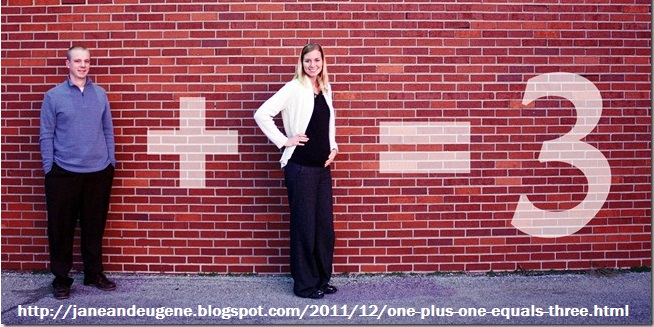
one plus one equal three (google image search)
And for those who come to this page thinking that they could create a page containing singles, duos (famous duos), ( Best Duos of all time), etc., quads/quartets (Vocal Quartets) (Famous and not so famous string quartets), etc., Vocal Quintets, Quintets in Opera, etc., and the other enumerated ensembles to be found in Music, sports, science, manufacturing, street gangs, employee cliques, military organizations, etc., by all means, please develop one that you would like to be placed on this page as a link.
Interestingly, I came across the phrase "Power Trio" alternatively applied to groups of three people in a music-oriented venue, though let us not fail to include the reference "Power Duo", so as to describe an absence of the word "power" as an attribute connected with other numbers. In other words, it is not customary to find references to "power ones/singles", Power fours, power fives, etc... Yet one may well think of such labels as Four Horseman, Fearsome Foursome, etc., just as we find number/quantity related words with prefixes referencing "enumerable" values such as Bi (two)- Cent (one-hundredth)- Deca (ten)- Di/Du/Duo (two)- Hemi (half)- Hexa- (six) Milli (one-thousandth)- Mono (one/single)- Multi (many/multiple)- Oct (eight)- Tri (three)- Quadri (four)- Hept (seven)- Penta (five)- Poly (many/multiple)- Semi (half)- Sept (seven)- Sex (seven)- Uni (one/single)- etc... as designated number-words. The usage of alternative number words in chemistry and biology (as well as psychology, such as "dichotomy", and philosophy such as Monism (see also: Wikipedia: Monism- DualismDualism (see also: Wikipedia: Dualism)- Pluralism (see also: Wikipedia: Pluralism, etc..)
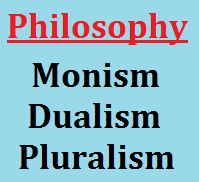
With respect to the terms "monism, dualism, pluralism" as they are used in philosophy, they are not "attentively" described as quantitative terms representing a complex way of illustrating the primitive approach at counting with the words "one, two, many"... even though the simplicity is lost in the applied attempts at projecting a complexity of intellectualization. Very often we find simple themes being elaborated on by the addition of a personalized algorithm (mathematics formula... set of rules) even if typical terms found in mathematics are not being used as part of the description. The use of describing ones, twos and many by way of words such as "duos" and "trios" or groups/bands/ensembles/orchestra (to represent "man"), is a tale-tell sign that the human mind is recreating, over and over and over again, the same simplistic themes of number orientation once used by primitives in their evolutionary development of number usage. Not only are many people overlooking the connection between their cognitive behavior and that of primitives, but that it represents humanity being stuck in a rut... cognitively speaking. Though we use different words and various themes to elaborate perceptions, those perceptions are related to the simplistic narrations once used by primitives. It matters not if you have a room full of world-renown PhD's in a prestige University setting talking about Monism, Dualism, Pluralism. They are basically talking about a human cognitive limit exercising the primitive One- Two- Many... albeit, being oblivious thereof between the connection. And it matters not what context or what words or what applications are being used to describe such references, this doesn't change the fact that a simple form of enumeration is playing out and that it is a recurring cognitive limitation.
Here are some examples of three-part logic formulas:
|
3-part Logic Thesis~ Antithesis~ Synthesis Indulgence ~ "Middle Way" ~ Ascetism Major Premise ~ Minor Premise ~ Conclusion Contradiction ~ Excluded Middle ~ Identity Principal |
||
|
"God-ology": Omnipresent Omnipotent Omniscient |
"Metaphysics-ology": What is real How change comes What is mind |
"Dialectology"
Marx): Unity of opposites Quantity & quality Negation of negation |
|
Epistemology: How we know What is truth What is mind |
Axiology: Nature of good Nature of beautiful Nature of religious |
Ontology: Quality (1st-ness) Relation (2nd-ness) Representation (3rd-ness) |
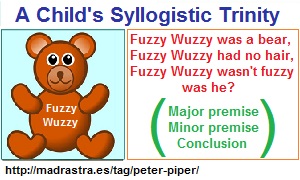 |
||
Source: Let's Talk Peace page 6
While some coming to this page will necessarily skip over the opening comments in order to review the images because they are more inclined to see the world through simplistic formulas of visualization, a few of you may come to appreciate that a "study" of threes involves fundamental concepts found in a variety of subjects such as Set Theory in mathematics and the enumerated structure found in one area of Musicology because it deals with cognition, audiology, psychology, philosophy, history, etc... For example, in noting that at least some primitive peoples followed a course of adopting numbers as a symbolic means of communication applied to everyday interests involving commercialization and personalized possession expressed by the three-part grouping of "one-two-many"; such that "in the beginning" of a developing number system, early peoples developed (in their own language equivalent way), a word which represented the value "1". It was a sort of Renaissance if not revelation in both cognition and language which altered socialization. With respect to the development of language, we find a reference to its development being interpreted as being something "other-worldly" by the biblical description: "In the beginning was the Word, and the Word was with God, and the Word was God". While people in a religious context are describing a biblically-related orientation, it also relates to the time when humanity moved beyond grunts, growls, snorts, and other pre-language expressions... though many of which remain disguised with the formality of a word or words; the point to be made is that the transition in the development of the physical apparatus (Larynx) and cognitive means to speak, could be interpreted in an awe-inspiring way and applied to the social circumstances one is subjected to such as an animistic, fertility worship, phallicism or other religiously-defined perspective.
With respect to music theory we can find various techniques of analysis such as using sounds, numbers, letters and linear as well as circular models, with
a distinct absence of a triangular one, when modes or scales are used. An exception might be in the
use of a triangular model applied to Music therapy.
Source for Circle of Fifths: The Circle of Fifths Explained
Source for Music Therapy triangle: The Ontology of Music in Music Therapy
As with genetics, and mathematical development (as cited by the recurrent usage of a small range of numbers employed for day to day usage such as the one-two-many set), we find that there is a limitation in music as well, meaning that the incrementally deteriorating planetary environment which we are exposed to is imposing restrictions on biology for the purposes of being able to maintain some semblance of an adaptive equilibrium state... albeit on a course of extinction.
Scales are collections of tones that divide octaves into specific intervals used to create music. Since humans can distinguish about 240 different pitches over an octave in the mid-range of hearing [1], in principle a very large number of tone combinations could have been used for this purpose. Nonetheless, compositions in Western classical, folk and popular music as well as in many other musical traditions are based on a relatively small number of scales that typically comprise only five to seven tones.
Source: A Biological Rationale for Musical Scales by Kamraan Z. Gill and Dale Purves
And yet, while some readers may be quick to jump at what appears to be a chance to downplay the presence of "threes" by citing the above 5 and 7 tone reference, it must be recalled that triads are often accompanied by additional sets involving one, two, or three, and that multiple sets-of-three may be combined but go unrecognized as multiple sets of three because those doing the counting (such as in the present case of sounds) are not, including an awareness of the many threes related to hearing: Language Threes page 1. Such "counters" may even be oblivious to the usage of three fingers in holding a pen or pencil as well as using three sentence-ending punctuations as the period, question mark, and exclamation point. Like someone having come up a Morse code key, they have difficulty distinguishing the pauses being used by an experienced Morse Code technician. In understanding Morse code:
. DIT: one dot/1 tap (use one finger) _ DAH: DIT x 3 / 3 quick taps (use three fingers for convenience) By definition the duration of the DAH should be three times of DIT. Therefore if you fasten your tap tempo you can represent DAH with three very quick taps, the duration of which is much shorter than three consecutive DITs. Lets take few examples, Letter A: DIT DAH Taps: Tap <pause> TapTapTap Letter I: DIT DIT Taps: Tap <pause> Tap Word SOS: DIT DIT DIT DAH DAH DAH DIT DIT DIT Taps: Tap <pause> Tap <pause> Tap <pause><pause><pause> TapTapTap <pause> TapTapTap <pause> TapTapTap <pause><pause><pause> Tap <pause> Tap <pause> Tap. Note: there is three unit <pause> between letters and seven unit <pause> between words. Source: How do you send Morse Code just by tapping? by Anshuman Anshuman, PhD Scholar, Program Analysis and Compilers |
While set theory can be described with some rather elaborate mathematical symbolization, a Venn diagram can be used to provide a simplistic representation of the "one- two- many" primivity of thought that humanity continues to repeat with various embellishments, but the underlying conceptualization involves one— one and two— one and two create a third. Here is a non-enumerated example:
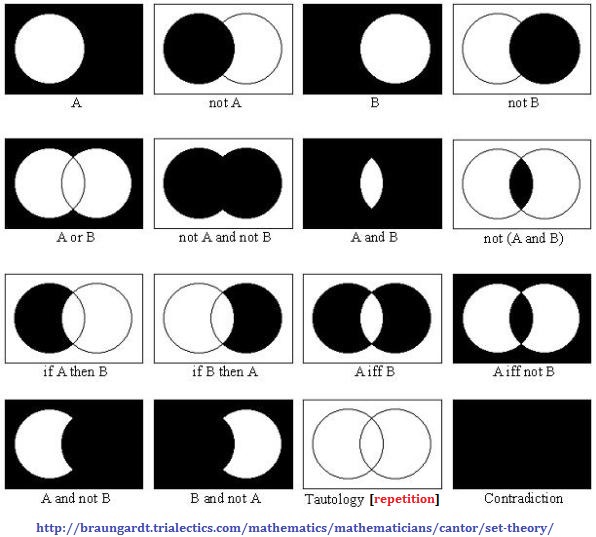
A History of Set Theory
The above example expresses "three" or "many" if we view the "Not A- Not B" expression that is not empty. The lack of emptiness implies a "somethingness" which we might describe as a "C" or a "3" or some value of "many". Hence, there is a third item even if it is not explicitly conveyed in this type of illustration. While we could include multiple sets, they would be multiples of the initial set-of-three formula, even if we used only one or two items, with an "empty" set such as might be conveyed by the following triad- plus- dyad ensemble of math enclosures, being left open to one's imagination:
 |
Types of brackets include:
|
Source:Math is fun
With respect to set theory, we can say that the "one-two-many" counting system is a cognitive limit that can be described as a set-of-three, though its initial stages of development involved a set-of-one, and then a set-of-two (1), (1-2). Sets-of-three are still being used in that we place a comma after a set-of-three called {ones-tens-hundreds}, and all sets-of-three thereafter, suggesting that the primitive cognitive limitation is alive and well. If we look outside the domain of numbers into letters and symbols not customarily assigned with a number value, we find that even though there are 26 letters to the English alphabet, in teaching the alphabet to the young we describe it with a set-of-three called "A-B-C's", not ABCD's, ABCDE's, etc... In other words, we have a 26-letter alphabet but generally describe it in terms of a three-lettered reference such as is illustrated when we ask a child if they know their "ABC's". It is not generally customary for one adult to ask another adult or even older grade school child if they know their alphabet, since their age is typically used to determine that they should know it.
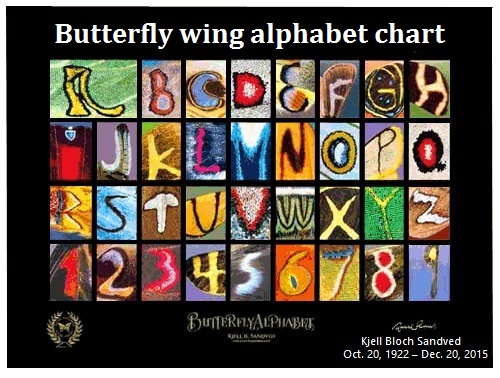
Another expression of the primitive limit of cognition is found in the American standard of clothing sizes and rate increases. For example, we say small-medium-large as a set-of-three and express this cognitive limit more intensely by straining to represent some value greater (or lesser) than these three through a standardized repetition of quantity which also represents a referral to 1-2-3, though we use the symbol "X" when we say X-XX-XXX large in the American system of clothing, though there also is an enumeration formula which is equivalent. In other instances, the sizes may be altered to accommodate new sizes, though the same referencing mechanism underlies the change. In such instances we see a shifting of the basic three sizes accompanied by attendant sizes which use the basic three (small-medium-large) as points of reference like a tag-a-long child or an unseen umbilical cord.

With respect to rate (speed) increases used on some domesticated electrical equipment such as fans and some lighting applications, we another set-of-three called slow-medium-fast. We have difficulty in developing concepts that are higher than three, and attempt to fool ourselves into thinking this is accomplished by repeating the same one-two-three sequence by way of repetition like the re-duplication seen in the babbling of infants who express a variety of sounds but follow a developmental sequence of one such as using the two letters "ba" (or na, da, di, ti, etc...), then proceed on to a two-sound variation such as ba-ba, and then a three-word variation such as ba-ba-ba, followed by a long string of repetition before proceeding onto the word development stage which repeats the one-two-three set of cognitive/linguistic expressions followed by an "explosion" of many words whose underlying usage appears to follow a fundamental three-patterned organizational methodology concealed and elaborated by various linguistic and ideological playfulness.
In displaying the cognitive excerise of the one-two-many set, we may use words, pictures or adopt some abstract convention such as using letters A-B-C, X-Y-Z, etc., or even employ three sounds, two sounds interrupted by silence, one sound interrupted by two intervals of silence, etc... An example of this is the Morse Code operation of dots and dashes interspersed with pauses... though the pauses can occur quite quickly as do the dots and dashes. Another example is that seen in Braille, which used two rows of three-dot positions. A third example is seen in that referred to as the Bagua or Pa Kua in Chinese and as Trigrams in English. However, the usage of a "three" in describing the eight groups of lines is a superficial examination in that if one looks more closely, the groups actually represent two types of lines which we may reference as one and two lines, with a distinct absence of any actual three-line configuration. One might even use a mixture of various components such as sight, sound and taste. The following image describes one such illustration:
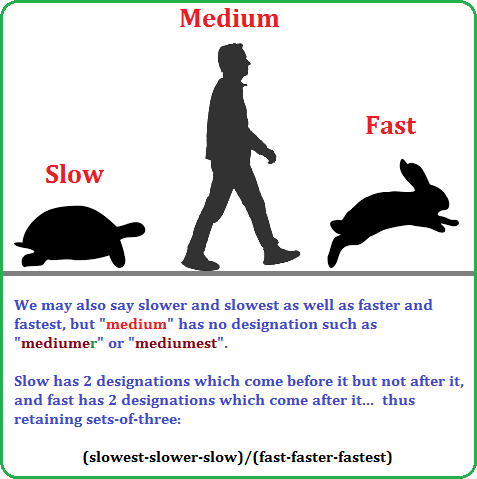
In counting higher than three, we appear to attempt an unrecognized concealment of the one-two-many grouping by using words and illustrations which are meant to give an impression of having devised a means of having surmounted the primitive plateau, but in actuality are an exercise in adding or overlapping the primitive sets of (1), (1-2), (1-2-3/many). In other words, we may use a word such as "four" to describe what we are taught to think is a cognitive area beyond the "three", but is in actuality a word describing three plus one (3+1). Or if you prefer, a triad, trinity, triangle plus one. For example, (1-2-3) + (1), though in using a Venn diagram we could use just two intersecting circles to describe three different areas by overlapping them, suggesting that the "3" can easily be viewed as an attribute of two and that two can be viewed as an attribute of one through a dissection. In the case of higher-than three ensembles that we are designating with words such as trinity, triad, triangle, etc..., a "5" group can be viewed as a triad plus a dyad... or in a sequential counting format, the addition of two more is a second set-of-three, albeit being one short of the "three". A "6" is two groups of three and a "7" begins yet another set-of-three, unless one prefers an alternative set-descriptive formula.
Incidentally, please note that in looking at the variety of enumerated forms (ones, twos, threes, fours, five, sixes, sevens, eights, nines, etc...), there is a limitation. In other words, we do not customarily form groups in large numbers as a routine. Very often we encounter what can be described in terms of the primitive counting scheme of "One- Two- Many", though words, sound, pictures, mental images/impressions involving thoughts, feelings, or sensations, may be the representation which does not become illustrated nor articulated. This is due to what I believe is an imposed limitation created by the planetary system and environment we are exposed to, which forces us to adapt to its incrementally increasing deterioration as a survival mechanism, and that by so doing instead of leaving the planet and the solar system... if not galaxy, humanity will eventually die out as will the planet and solar system. It's not that we can't think in large numbers, it's just that thinking in large numbers is not a customary practicality for the given environment we humans are subjected to.

Note: Some of the items were "randomly" picked up on the internet and therefore do not have a referential link. I also have not appreciably included the numerous images with a dog, horse and horse rider, three animals, two people and a dog, etc... It should also be mentioned that I do not cover the many trios which probably exist in other cultures and are take for granted as being commonly known from the perspectives of different generations (age groups). Take for example the choice of fishing hooks and bowling ball grip:
 |
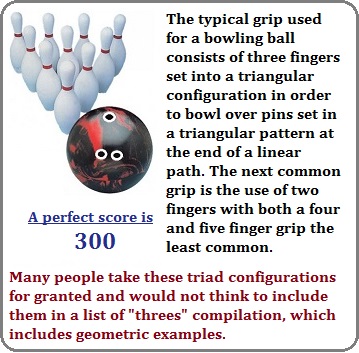 |
In a few of the following examples I have presented a "three" model such as with respect to the Types of RNA, when in fact there are multiple other forms, but that the triad of "Messenger-Transfer-Ribosomal" nonetheless serves to represent a widely used cognitive schema... even if some feel this is a "Lie to Children" and that the brains of children today are "ready- willing (and) able" to utilize more complex information being offered in Universities... or so some wish to think. Whereas the view is discussed as a lie, then the origin of the lie must rest in the inability of the human brain to grasp reality as it truly exists in the first place, by way of the normal and natural mechanisms of our physiology, and that to unravel many lies we need to adopt means, methods and mechanisms which are not part of our natural senses... hence, a microscope for example, is thus a "lie" because it is a type of artificialized construction which is believed to have been developed to discover greater truths, but that such truths, like beauty and peace, are none-the-less in the eye, heart and mind of the beholder... filtered by the day and age one is born into and one's personal biases.
No less, a truth can be use for both good or evil. And that some believe there are those truths which are better left to a future day and age when humanity is thought to be able to appreciate and utilize them with the prerequisite wisdom. Yet in speaking of lies told to children we must also speak of lies told to adults such as those perpetrated by theologians, politicians, story tellers, businesses, scientists, doctors, and others wanting to manipulate the adult public for one reason or another... and thus reveal or conceal exploitation to sell a service, idea, product, position, etc... It is rather foolish to speak of lying to children when lying to adults is a much bigger issue and becomes established as a tradition, fad, cultural icon, etc... Lies which are intentional and those that are due to the tellers ignorance. Hence, the philosophy governing the "lie(s) to children" is itself a lie to adults because it is appreciably absent from expressing a larger truth involving a much broader perception of the discussion. Even if we defined a "lie to children" as "a simplified explanation of technical or complex subjects as a teaching method for children and laypeople"... restricting the parameter of the word "lie" to attempt a specific distinction is itself a lie and a move to constrain the discussion within a narrow corridor so as to eliminate objections, like a mathematical equation whose symbols and explanation do not permit alternative interpretations.
In describing lies told to children... or adults with the minds of children such as in terms of unquestioning patriotism for a falsified democracy, a falsified origin belief in the Christian doctrine of the Trinity (it is said to be a mystery), etc., the source(s) of those lies are many-fold and are not restricted to the conventional public school education process. Take for example the episode entitled "Renegade" in the old Lone Ranger Television series. The opening explanation of the Native American situation and how they were treated by the "Great White Father" in Washington is a ludicrous representation of actual experiences by Native Americans. Either the writers of the show were ignorant of historical facts, or were engaging in a type of self-denial about the disgusting treatment the Federal government dealt to the Indian peoples. Did the writers or producers of the show not know history, or was there an intentional decision to lie? And what about historians who "fudge" the details of research to fit within the confines of their beliefs which may have provided them with money from book sales? Or the many lies men tell to women and vice versa? Or the perpetration of a lie transformed into a belief and consequently called sacred or a "Natural\(or)/Civil" law? When we take a larger look at the situation of "lying" both to children and adults, the idea about the "lie to children" becomes a fanciful summary of a much larger issue the authors of the idea deliberately lied to themselves about because it is a topic far beyond the mere purview of their simplistic rationale. When we live in a reality made up of a broad assortment of "white-lies", half-truths, and numerous other labels to describe what we adults believe to be a greater clarity of truth, history reminds us that even many of our so-called views on Natural Laws come to be supplanted by later realizations of greater clarity within specified applications for given circumstances. The "Lie to Children" is just another perspective of a very large genre of lies perpetrated by humanity to which we can apply the word "cheating" to describe many of the contexts in which lies appear, and is itself an over- simplification of a complex phenomena that the authors do not coherently express because they do not grasp the larger issue themselves. They resort to the usage of a simplicity not only for the sake of rendering a complex idea into a conceptual model with which to present to others equally and less astute than themselves, but to conceal their inability to express in terms more suitable for explicating a very large array of seemingly disparate material.
Page initially created: Friday, 17th August 2018... 4:36 AM
Page initially posted: Friday, 14th September 2018... 6:12 AM
Page Updated: Friday, 13th September 2024... 7:27 AM
Herb O. Buckland
herbobuckland@hotmail.com